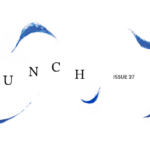Menu
Safety by Alison Fishburn
In Alison Fishburn’s flash creative nonfiction piece “Safety,” the technical, detailed nature of the writing subverts expectations and takes on new meaning as the story behind the objects being described is revealed.
I wear a powerful spring on a cotton cord around my neck. The spring is a thick steel coil coated dark blue, about two inches long. It used to be compressed to half its size inside a device called a brake cartridge, a safety mechanism the size of my hand, plugged into a table saw that uses electrically-charged saw blades. Should one of these electrically-charged saw blades come into contact with a conductor of electricity—such as a finger in the wrong place at the wrong time—the electric signal to the blade changes, activating the brake cartridge within five milliseconds. Within those five thousandths of a single second, while a finger and life attached to it hang in peril, the powerful spring is released, sending a molded aluminum stop into the spinning blade, reducing the blade’s rotational speed from 4,000 times per minute to zero, saving the finger and life attached to it.
I found the spring in the bottom of an industrial-sized plastic trash bin in a woodshop where I sometimes work. What caught my eye first, though, was the discarded ten-inch blade embedded into the aluminum stop of the brake cartridge next to the spring.
Among wood scraps and sawdust, the combined object was mesmeric, machine versus machine, a snapshot artifact of averted danger; safety.
I pulled the blade from the trash bin for a closer look. I inspected the way the curved teeth of the blade bit all the way down into the aluminum stop. I imagined witnessing the moment of impact and I wanted a souvenir for what I had imagined. I dropped the blade back into the bin, opting to keep the powerful spring because it fit inside my pocket.
I have another souvenir, an airbag I never look at.
The airbag is a sheet of white nylon that used to be compressed inside the steering wheel of a you know where this is going.
Should a car come into contact with an obstructive object, and crash, an array of electric sensors in the car are triggered, activating the car’s safety system.
Within five hundredths of a second, the number of airbags deemed necessary for the type of crash detected are deployed. In the steering wheel, a canister of sodium azide, a white odorless poison, is lit by an electric match, causing a chemical reaction. The sodium azide is converted into nitrogen gas and inflates the airbag, preventing the driver’s head and chest from hitting the steering wheel.
I found my souvenir airbag on a car in a tow lot, the collateral damage of a head- on crash with a charter bus. I was told the driver of the car had died instantly because not even the airbag could have saved her life.
What caught my eye first at the car was my dad, because he was retrieving personal effects from behind the driver’s seat. Then he wailed, falling backward, catching himself on the ground as though the ground had prevented him from falling any further. I was standing next to the car, looking through the space where there should have been a door, observing the driver’s seat, the painted outline of my sister’s figure in stains of char and blood. I took a step toward my dad but stopped because I saw what sent him falling. And I looked away from the pool of liquid red on the floorboard behind my sister’s outline, and the first thing I saw when I looked away was the steering wheel bent upward in a ninety-degree angle and the deflated airbag laying on top.
I went to the airbag. I inspected the piece of cloth that couldn’t have saved my sister’s life. And I imagined the airbag was the last thing to touch her when she was still alive. And I decided I would keep the airbag as a souvenir because it was a final moment with my sister, an artifact of our missed goodbye.
Sometimes I hold the cotton cord on either side of the powerful spring around my neck. I rotate the cord until the motion spins the spring. I pull the cord tight, watching the spring snap to a stop. I do this again and again because I like watching what I can control.
Other times, without thought, I wrap the cotton cord around my hand like a rosary. Or I’ll pinch the spring with my fingers, a futile attempt to compress it to the original size it would have been inside the brake cartridge, before it was activated within five thousandths of a second, which is ten times faster than an airbag could save a life.
Alison Fishburn is an American writer living in Paris, Ontario. Originally from Florida, she has written and self-produced three full-length plays in New York City, studied acting and playwriting at The Barrow Group, and studied and performed improv at the Magnet Theater and Upright Citizens Brigade. She has an art degree from Brooklyn College and an MFA in creative nonfiction from University of King’s College in Halifax. Her writing has appeared on Longreads, The Outline, and SAND. She is currently writing a memoir about her younger sister’s unexpected death in 2013. This piece appears in SAND 24.
KEEP ON READING
No Comments
From Pantyhose for Daisy by Dewi de Nijs Bik tr. Emma Rault
Poetry | Issue 26: Shifting (translated
No Comments
No Comments

